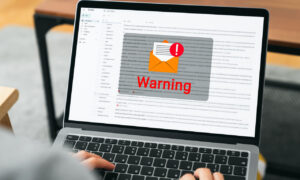In our previous Insights, we discussed the importance of having a Business Continuity and Disaster Recovery plan (BCDR) for your business and the basics of cybersecurity. This month, we are bringing the two together and exploring why including cybersecurity in your BCDR plan is a critical step you can’t afford to ignore.
A comprehensive BCDR plan ensures that you are prepared to withstand potential disasters or emergencies—both manufactured and natural—that may affect your business operations. Without it, an unexpected disaster can quickly spiral into a business-ending event.
As we all know, cyberattacks are becoming increasingly common and sophisticated. A single cyberattack can cause a business to lose significant amounts of money, data, time, and reputation. Let’s look at four major ways disasters amplify cyber threats and what strategies you can utilize to bolster your cybersecurity posture in the face of adversity.
1. Leveraging diverted attention and resources
When a disaster strikes, the immediate focus shifts toward safety and recovery. Unfortunately, this diverts attention and resources away from maintaining and protecting your IT systems and networks.
With a reduced emphasis on cybersecurity measures, essential updates and monitoring may be overlooked, leaving your networks vulnerable to intrusion. Cybercriminals seize this opportunity to infiltrate your systems, compromise sensitive data, and disrupt your operations.
To tackle this situation, establish a dedicated team responsible for monitoring and maintaining cybersecurity, even during times of crisis. Implement automated security systems to scan for vulnerabilities and apply necessary patches continuously. By ensuring cybersecurity remains a priority, even in challenging times, you can minimize the risk of cyberattacks.
2. Exploiting fear, urgency, chaos and uncertainty
Disasters create an environment of fear, urgency, chaos, and uncertainty—prime conditions for cybercriminals to thrive in. They launch targeted attacks, such as deceptive emails or fraudulent websites, capitalizing on the sense of urgency and the need for quick solutions. By manipulating individuals into disclosing sensitive information, cybercriminals gain unauthorized access to critical systems.
To combat this, educate your employees about the tactics used in phishing attacks and social engineering scams. Train them to recognize warning signs, such as suspicious emails or requests for sensitive information. Encourage a culture of skepticism and verification, where employees double-check the authenticity of requests before sharing any data, especially confidential data.
By fostering a vigilant and informed workforce, you can fortify your defense against cybercriminals seeking to exploit fear and uncertainty.
3. Damaging critical infrastructure
Disasters can cause severe damage to your critical infrastructure, compromising components integral to your cybersecurity measures. Destruction of servers, routers, or firewalls can weaken your defense mechanisms, allowing cybercriminals to exploit security gaps.
To address this challenge, ensure your critical infrastructure has backup and disaster recovery in place. Regularly back up your data, store it securely off-site or in the cloud, and test the restoration process to ensure it functions smoothly. Implement robust disaster recovery and business continuity plans, including provisions for cybersecurity.
By maintaining resilient infrastructure and regularly testing your backup and recovery processes, you can mitigate the impact of infrastructure damage on your cybersecurity.
4. Impersonation and deception
In the wake of a disaster, cybercriminals often exploit the trust associated with relief organizations and government agencies. By impersonating these trusted sources, they deceive victims through phishing emails, messages, or calls, tricking them into divulging sensitive information or engaging in fraudulent transactions.
To protect your business from such scams:
- Encourage your employees to verify the authenticity of any communication received during a disaster.
- Advise them to independently contact the organization or agency through known, trusted channels to confirm the legitimacy of any requests.
- Establish robust security awareness training programs that educate employees about common impersonation tactics and teach them how to report them effectively.
By promoting a culture of caution and verification, you can defend against impersonation and deception tactics used by cybercriminals.
Act Now to Safeguard Your Business
Now that we know how cybercriminals can target your business during a disaster, prioritizing disaster preparedness and implementing the above-highlighted measures are essential to navigate today’s ever-evolving technology landscape.
As always, we’re here to help fortify your disaster preparedness and cybersecurity efforts. Together, let’s ensure a resilient and secure future for your business. Contact us today to proactively safeguard what you’ve worked so hard to build.
BONUS: Ready to Disaster-Proof Your Business?
“Weathering the Storm: A Business Leader’s Guide to Disaster Preparedness” will help you:
- Assess your business’s vulnerabilities
- Formulate a practical disaster preparedness plan
- Implement preventive measures
- And more
Now’s the time to take control of your business’s continuity. Embrace the power of preparedness and stand firm against any adversity.







